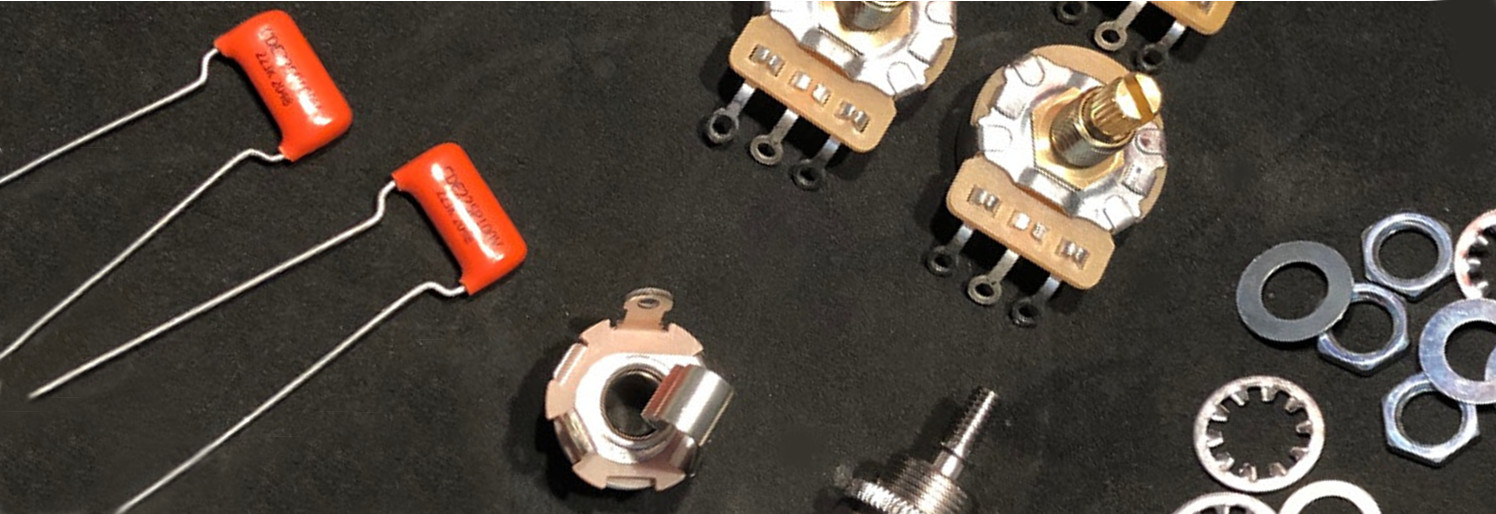
Support / Wiring & Harness FAQ’s
Please find a list of helpful guitar wiring harness information and general questions.
Q: Can you make me a custom Wiring Harness?
A: YES! We can create a custom harness to your specifications! Most custom builds can be completed within 2-4 days! To order a custom Wiring Harness, Please Get In Touch
Q: My tone is muddy, Can I brighten it up?
A: There are several things you can do to brighten up your muddy tone. First of all try adjusting the height of the pickups, if they are far from the strings you will not get a bright tone. Secondly, try changing your Potentiometer value, if using 250K try 500K. Thirdly, try connecting a .047 capacitor in series with the hot output line of your pickup – the capacitor acts as a filter to remove excessive low-end. Lastly, you can change the tone Cap to a lower value such as 0.022 or 0.015.
Q: Which pots would you recommend for my pickups?
A: For humbucker pickups and P90 pickups, we recommend 500K audio taper pots.
For standard single coil pickups, like those on Stratocaster or Telecaster electric guitars, we recommend 250K audio taper pots.
Jazzmasters typically use 1Meg pots.
Q: What is the difference between Audio and Linear taper pots?
A: Audio and Linear taper pots have the same resistance but differ in position of the pot at 50% value. Linear pots are usually marked with a B and will reach 50% of its total resistance in the 50% rotation point (half way). Audio taper pots are usually marked with an A and will decrease most of the resistance in the last 50% of the rotation, so most of the action is in the last part of the pot.
Q: How can I tell if I have a broken pickup, a bad pot or switch or a wiring problem?
A: The easiest way to diagnose bad components and pickups is to measure their DC resistance with an Multimeter. You can buy a basic Multimeter for about £8 online. Most pickup manufactures provide a basic output figure for their pickups you you to check against. Potentiometers should range from 0 to their given values like 500k, 250k. Switches should read either infinite or zero ohms depending on their position. You can also use an Multimeter to check your signal path and wiring soldering/connections.
Q: What does a volume “treble bleed” capacitor do?
A: A volume “treble bleed” capacitor is used on a volume control pot to prevent treble frequency loss as the volume pot is turned down. This is done by placing a small capacitor (usually .001 MFD) between the input and output terminals of the volume control pot. As the volume is reduced, the capacitor allows high frequencies to bleed through to the output and keeps the tone from getting muddy at lower volume settings.
Q: What does a capacitor do?
A: Capacitors are energy storage devices that filter the high frequencies. A capacitor lets the tone control roll off the treble response, progressively warming the tone. The higher the value, the more bass output from the tone control at its “zero” setting.
Q: I want to change my capacitors. What is your recommendation?
A: This decision really come down to person preference, your music style, and the tone you are aiming for. A higher value pot, like a 0.047, will roll off a wider band of top-end frequencies. A lesser value pot, like a 0.015, will roll off a narrower band of top-end frequencies. The .047 will also roll off that wider band of frequencies “faster.” So with a small adjustment of the tone knob you will hear more of a difference. Capacitors are normally easy to change, so this makes experimenting simple. Once you have done with the mechanics of it and have a capacitor value that works for you, you can then look at the different types of caps to choose from with regards to quality, like Orange Drop caps, Paper in Oil caps and Ceramic caps. Prices range from £1 to £99.00.
Q: Whats the tone difference between Orange Drop Capacitors and the more expensive Paper in Oil Capacitors?
A: The general norm is that most people would say that Paper in Oil capacitors have a bit more natural sound to them. They cost more money, because they are often made by hand and not mass machine produced in a factory. The pecking order is as follows: Ceramic Caps, Orange Drop Caps and then Paper in Oil. Prices go up accordingly.
Q: Where I can find a wiring diagram?
A: All of our wiring diagrams and fitting instructions are on our support HERE
Need More Help? / Get in touch
